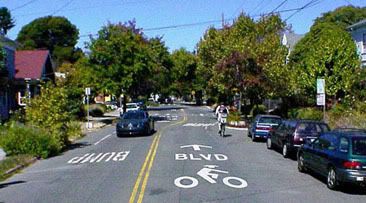
In the recent years, there has been more attention to bike planning in Long Beach, it may be that the notion of bicycles as a viable mode of transportation came into public focus during last year’s Amgen Tour of California. To try to cement a regular place as the tour’s finish line, many City officials had advocated working to see that Long Beach becomes known as one of the most bike-friendly cities in the nation. This is a big task considering where we are now; nonetheless, it is an attainable goal, given Long Beach’s favorable weather, geography, and patterns of development. Our Southern California climate, with moderate temperatures and relatively low rainfall, is ideal for bicycling. In addition, except for a few small hills Long Beach is entirely flat: for the most part, bikers need not struggle up hills when getting around town. Finally, Long Beach is fairly dense, because much of the city was developed in the early and mid-twentieth century, and bounded by the ocean to the south and by the Los Angeles River to the west.
Unfortunately, Amgen decided to complete their bike race in a different city this year. However, this certainly does not mean that efforts to make Long Beach more bike friendly will cease. Given that Long Beach has so many key ingredients to become a bicycle-oriented city, the remaining effort is largely one of connecting the dots. Central to this is the need to focus on creating supportive regulations, better education, and an overall awareness about the personal and social benefits of bicycling. Where financial investment would be needed is in improved bike facilities, paths, racks, and signage. The update of the city’s general plan, Long Beach 2030, presents an excellent opportunity to broaden discussions in regard to more intensive bike planning. Such discussions could cover topics and recent innovations not mentioned in Long Beach’s Bike Masterplan, which was already more than five years old.
To hold an informed and effective conversation about bike facilities, common definitions are sorely needed. There are three basic classes of bike facilities. Class I bike facilities are paths separated from automobile traffic; the popular path along the beach is a local example of a Class I bike facility. Class II bike facilities are dedicated bike lanes that typically run along the right shoulder of a street; such a lane currently exists along Bellflower Boulevard in eastern Long Beach. Class III facilities are streets designated as bike routes; in other words, these facilities are regular streets, with bike route occasional signage to remind automobiles that bicycles are likely using the street as well.
About a month ago, an article appeared in The District magazine entitled Bully-vard. The article discussed a public meeting concerning a proposed bike route (that is, a Class III facility) to run from east to west through the Bluff Park neighborhood. At the meeting local residents expressed both opposition and support for the idea. One motivation for this proposed route is that outside the beach bike path, First Street and Second Street through Alamitos Beach, Bluff Park, and Belmont Heights already represent popular informal east-west bike corridors in Long Beach, even without any designation. The current effort on the part of the city is to try to increase awareness of these streets as suitable for bicycles, and also to make them safer. A corollary of this initiative is that such designations would work to discourage cars from speeding down these residential streets.
Bike boulevards are a variation on the Class III bike route, developed originally in the city of Palo Alto, California (near San Jose). The Palo Alto Bicycle Transportation Plan defines a bike boulevard as a “low-volume through street where bicycles have priority over automobiles, conflicts between bicycles and automobiles are minimized, and bicycle travel time is reduced by the removal of stop signs and other impediments.”
This notion of bike boulevards is innovative because, Class III bike routes are located along major thoroughfares: for example, Pacific Coast Highway through Long Beach is technically designated as a bike route. Typically, such bike routes are not well utilized: few bikers are comfortable using such busy streets. In contrast, bike boulevards are placed along secondary streets that run parallel to major thoroughfares. To increase safety for bicyclists, automobile traffic is discouraged while non-stop bicycle travel is encouraged. This is done using traffic calming devices such as curb extensions, roundabouts and diverters. Such devices reduce the number of cars using the street in question, and also slow down those cars that are present. At the same time, removing stop signs along the bike boulevard permits non-stop travel for bicyclists.
For residents of First and Second Streets in the Alamitos Beach, Bluff Park, and Belmont Heights neighborhoods, cars trying to avoid traffic along Broadway and Ocean (the larger boulevards that bracket First and Second Streets) present a constant headache. Because First and Second streets are relatively free of traffic and relatively wide (particularly in the Bluff Park neighborhood), automobiles typically travel at fairly high rates of speed. At one point the Bluff Park neighborhood association even retained an engineer to design traffic-calming street features like roundabouts for the neighborhood.
Dust off those drawings! Bike boulevards can represent a convergence of goals for bikers and residents of Bluff Park and beyond. Bicyclists get safe, effective bike routes, while residents get traffic-calming devices that reduce automobile speeds as well as the volume of traffic cutting through their neighborhoods. This example of First and Second Streets is just one of many cases where “bike boulevards” could contribute to a more pleasant, safer, healthier, and environmentally conscious Long Beach for us all.

Bike Boulevard in Berkeley, California


